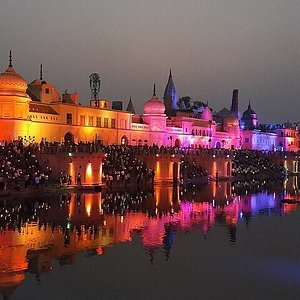Top 8 Places To Visit In Ayodhya : Ram Janambhumi
Here are 8 places to visit in Ayodhya with description. Below please check detailed places in Ayodhya.

Here are 8 places to visit in Ayodhya with description. Below please check detailed places in Ayodhya.
Ram Janmabhoomi
The Ram Janmabhoomi, which means "Birthplace of Ram," is thought to be the birthplace of Lord Ram, the Hindu god. The seventh incarnation of Lord Vishnu, known as Ram, is supposed to have grown up along the Sarayu river in Ayodhya, according to the Indian epic Ramayan. For Hindu believers, the Ram Janmabhoomi is a profoundly sacred location.
The Supreme Court of India granted a trust the right to erect the Ram Temple on the Ram Janmabhoomi land, which had been a contentious location for many years. PM Narendra Modi conducted the groundbreaking ceremony on August 5, 2020, to lay the foundation stone for the Ram Temple in Ayodhya. The temple's proposed design is opulent and stunning.
Hanuman Garhi, Ayodhya
Hanuman Garhi, a temple built in the tenth century honoring the Hindu deity Hanuman, is situated in Sai Nagar. Given that it is usual to visit Hanuman Garhi before visiting the Ram Temple in Ayodhya, it is one of the most significant temples in the city. It is thought that Lord Hanuman inhabited the temple complex that protected Ayodhya.
The 76 staircases that lead to the entrance of the hilltop shrine are refined. Inside the expansive panorama of the neighboring hills is a 6-inch-tall Hanuman idol. A grotto inside the main temple is home to several idols of Lord Hanuman and his mother, Maa Anjani. Thousands of devotees flock to the Hanuman Garhi during Ram Navami and Hanuman Jayanti, which commemorate the births of Lord Ram and Lord Hanuman, respectively.
Kanak Bhawan
In Tulsi Nagar, the Kanak Bhawan is located in the northeastern corner of the Ram Janmabhoomi. Sone-ka-Ghar is another name for this temple, which was built in 1891. This sacred location honors the Hindu god Lord Rama and his spouse, Goddess Sita.
The sanctum santorum (Garbagriha) of Kanak Bhawan, also known as Golden Palace, is home to three golden-crowned idols of the two gods covered by a silver ceiling. It is thought that Kaikeyi, Rama's stepmother, gave Sita and Rama this temple. Following planned renovations under Vikramaditya's rule, Vrish Bhanu Kunwari completely redesigned the current location.
Nageshwarnath Temple, Ayodhya
The Nageshwarnath Temple, which was built in honor of the local god Lord Nageshwarnath, is situated in Ayodhya next to the Theri Bazaar. It is thought to have been established by Lord Rama's son, Kush or Kusha.
Even though this holy location has been well-maintained since 750 AD, Safar Jung's minister Naval Rai is credited with rebuilding the present temple in 1750. According to legend, Kush met Naga Kanya, a Shiva devotee, after misplacing his arm ring in the neighborhood bath. This Shaiva temple was built by him for Naga Kanya. In Southern India, during Mahashivaratri and Trayodashi, also called Pradosh Vrat or Pradosh Vratam, the Nageshwarnath Temple draws a large number of people.
Gulab Bari
The Gulab Bari, also called the Garden of Roses, is located in Vaidehi Nagar. It is the final resting place of Nawab Shuja-ud-Daula, the third Nawab of Faizabad (Oudh or Awadh), as well as his parents.
The Gulab Bari's 18th-century building features fountains, luxuriant vegetation, and classic Nawab-style architecture, among many different kinds of roses. Currently protected as a component of the nation's history, Gulab Bari is listed under the Ancient Monuments and Archaeological Sites and Remains Act.
Treta Ke Thakur
The Treta Ke Thakur Temple, located in Ayodhya along the Naya Ghat, is home to a number of idols, including those of Lord Ram, Sita, Lakshman, Hanuman, Bharat, and Sugreev. One single black sandstone is alleged to have been used in the sculpture of these figures.
Treta Ke Thakur is thought to have been built 300 years ago by the Kullu monarch of that era. This building is supposed to be located on the exact spot where Lord Rama performed the well-known Ashwamedha Yagna. Ahilyabai Holkar, the Maratha queen at the period, substantially renovated the temple in the 1700s. It only opens to the public on the day designated as the Ekadashi once a year. On the eleventh of Shukla Paksha, this day is observed.
Choti Chawni
Choti Chawni, a majestic white marble edifice in Ayodhya, is also known as Valmiki Bhawan or Maniramdas Chawni. This location is quite breathtaking and well worth a visit.
There are 34 heritage caves total; 12 of them are Buddhist, 17 are Hindu, and 5 are Jain. This makes them an important and intricate feat of architectural design. The elaborate grandeur of the architecture is further enhanced by the Kailasha Temple within the caves.
Sita Ki Rasoi
Situated on the north-western side of the Ram Janmanhoomi in Ayodhya's Rajkot, Sita ki Rasoi is believed to be an ancient kitchen used by goddess Sita herself. Built quite close to the Ram Janmabhoomi, this sacred site is now a temple housing some exhibit vessels. One among the two kitchens revered in Sita's name, this Sita Ki Rasoi is a basement kitchen.
The other end of the temple cites the richly clothed and embellished idols of Ram, Lakshman, Bharat and Shatrughan and their wives Sita, Urmila, Mandavi and Srutakirti. Worshipped as the Goddess of Food, Sita is also known as Goddess Annapurna. Thus, the temple follows this tradition by offering free food. Visitors can also donate any amount of money for charity here.
What's Your Reaction?

















